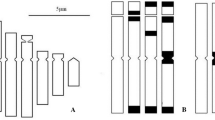Abstract
Large scale changes in nuclear DNA amount accompany the evolution of species of higher plants. Much of the nuclear DNA accrued during the evolution of species does not encode genetic information and is selectively neutral. Nonetheless, the pattern of distribution of the excess DNA within and between chromosome complements suggests that there are rigid constraints underlying evolutionary changes in genome organisation.
A five-fold increase in the amount of nuclear DNA has occurred in the evolution ofLathyrus species. Not withstanding this massive DNA variation, species show consistently similar patterns in base sequence proliferation, divergence and DNA distribution within and between chromosome complements. Within chromosome complements, the excess DNA is distributed evenly in all chromosomes irrespective of the large differences in chromosome size and, between complements, DNA distribution is discontinuous; species cluster into DNA groups with remarkably regular intervals. Similar constraints govern the frequency and distribution of chiasmata in the chromosome complements. Between species chiasma frequency and nuclear DNA amounts are not correlated but within complements it is positively correlated with the amount of DNA contained in each chromosome.
It is shown that constraints upon evolutionary changes in genome organisation could restrict or predetermine the outcome in chromosome evolution.
Similar content being viewed by others
References
Bennett M. D. 1983 The spatial distribution of chromosomes. InKew chromosome conference (eds) M. D. Bennett and P. E. Brandham, vol. 2, pp. 71–79
Brown D. D., Wensink P. C. and Jordan E. 1971 Purification and some characteristics of 5S DNA fromXenopus laevis.Proc. Natl. Acad. Sci. USA 68: 3175–3179
Calos M. P. and Miller J. H. 1980 Transposable elements.Cell 20: 575–595
Cuellar R. E., Ford G. A., Briggs W. R. and Thompson W. F. 1978 Application of higher derivative techniques to analysis of high resolution denaturation profile of reassociated repeated DNA.Proc. Natl. Acad. Sci. USA 75: 6026–6030
Dennis E. S., Gerlach W. L. and Peacock W. J. 1980 Identical polypyrimidine-polyuridine satellite DNA’s in wheat and barley.Heredity 44: 345–366
Doolittle W. F. and Sapienza C. 1980 Selfish genes, the phenotype paradigm and genome evolution.Nature (London) 284: 601–603
Dritten R. J. and Rhone D. E. 1968 Repeated sequences in DNA.Science 161: 529–540
Goodspeed T. H. 1954 The genusNicotiana. Chronica Botanica (Waltham, Massachusetts)
Hutchinson J., Narayan R. K. J. and Rees H. 1980 Constraints upon the composition of supplementary DNA,Chromosoma 78: 137–145
Jelenik W. R. and Haynes S. R. 1982 The mammalian Alu family of dispersed repeats.Cold Spring Harbor Symp. Quant. Biol. 47: 1123–1130
Kelley T. J. and Smith H. O. 1970 A restriction enzyme fromHemophilus influenzae.J. Mol. Biol. 51: 393–409
Kuriyan N. P. and Narayan R. K. J. 1988 The distribution and divergence during evolution of repetitive DNA sequences inLathyrus species.J. Mol. Evol. 27: 303–310
Lewin B. 1974Gene expression-2 (London: John Wiley and Sons)
Martin P. G. and Shanks R. 1966 DoesVicia faba have multistranded chromosomes?Nature (London) 211: 650–651
Maynard Smith J., Burian R., Kauffman S., Iberch P., Campbell J., Goodwin B., Lande R., Raup D., and Wolpert L. 1985 Developmenuntal constraints and evolution.Q. Rev. Biol. 60: 265–287
McClintock B. 1965 The control of gene action in maize.Brookhaven Symp. Biol. 18: 162–185
McGregor H. C. and Sessons S. K. 1986 The biological significance of variation in satellite DNA and heterochromatin in newts of the genusTriturus: an evolutionary perspective.Philos. Trans. R. Soc. London B312:243–260
Muller H. J. 1967 inHeritage from Mendel (eds) R. A. Brink (Madison: University of Wisconsin Press) pp. 419–447
Narayan R. K. J. 1982 Discontinuous DNA variation in the evolution of plant species. The genusLathyrus.Evolution 36: 877–891
Narayan R. K. J. 1985 Discontinuous DNA variation in the evolution of plant species.J. Genet. 64: 101–109
Narayan R. K. J. 1987 Nuclear DNA changes, genome differentiation and evolution inNicotiana.Plant Syst. Evol. 157: 161–180
Narayan R. K. J. 1988 Constraints upon the organisation and evolution of chromosomes inAllium.Theor. Appl. Genet. 75: 319–329
Narayan R. K. J. and Durrant A. 1983 DNA distribution in chromosomesof Lathyrus species.Genetica 61: 47–53
Narayan R. K. J. and Mclntyre F. K. 1989 Chromosomal DNA variation, genomic constraints and recombination inLathyrus.Genetica 79: 45–52
Narayan R. K. J. and Rees H. 1976 Nuclear DNA variation inLathyrus.Chromosoma 54: 141–154
Nei M. 1975 Molecular population genetics and evolution: Research Monograph.Frontiers of Biology 40. (Amsterdam: North Holland)
Raina B. N. and Rees H. 1983 DNA variation within and between chromosome complements ofVicia species.Heredity 51: 335–346
Rothfels K., Sexsmith E., Heimberger M. and Krause M. O. 1966 Chromosome size and DNA content of species ofAnemone. L. and related genera.Chromosoma 20: 54–74
Thompson W. F. and Murray M. G. 1980 Sequence organisation in pea and mung bean DNA and a model for genome evolution. InPlant genome (eds) D. R. Davies and D. A. Hopwood (London: The John Innes Charity) pp. 51–45
Varley J. M., Mcgregor H. C., Nardi I., Andrews C. and Erba H. P. 1980 Cytological evidence of transcription of highly repetitive DNA sequences during the lampbrush stage inTriturus cristatus carnifex.Chromosoma 80: 289–307
Vosa C. G. 1974 The basic karyotype of rye (Secale cereale) analysed with Giemsa and fluoresence methods.Heredity 33: 403–408
Waldeyer W. 1988 Uber Karyokinese und ihre Bezeihung zu den Befruchtungsvorgangen.Arch. Mikr. Anat. 32: 1
Watson J. D. 1965Molecular biology of the gene (New York: Benjamin)
Welleur P. K. and Dawid I. B. 1974 Secondary structure maps of ribosomal RNA and DNA.J. Mol. Biol. 89: 379–395
Winkler H. 1920Vererbung und ursache der parthenogenese im flanzen und Tierreich (Germany Fischer/Jena)
Author information
Authors and Affiliations
Rights and permissions
About this article
Cite this article
Narayan, R.K.J. Molecular organisation of the plant genome: Its relation to structure, recombination and evolution of chromosomes. J. Genet. 70, 43–61 (1991). https://doi.org/10.1007/BF02923577
Received:
Issue Date:
DOI: https://doi.org/10.1007/BF02923577



